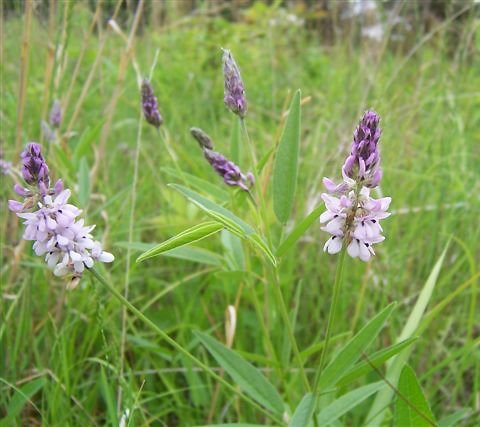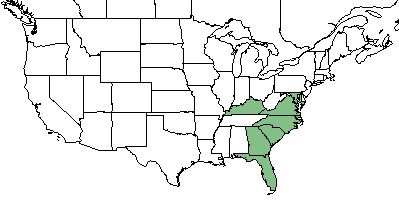Orbexilum pedunculatum
Common Names: Sampson's snakeroot[1]
| Orbexilum pedunculatum | |
|---|---|

| |
| Photo by John Hilty at IllinoisWildflowers.info | |
| Scientific classification | |
| Kingdom: | Plantae |
| Division: | Magnoliophyta - Flowering plants |
| Class: | Magnoliopsida - Dicots |
| Order: | Fabales |
| Family: | Fabaceae |
| Genus: | Orbexilum |
| Species: | O. pedunculatum |
| Binomial name | |
| Orbexilum pedunculatum Miller | |

| |
| Natural range of Orbexilum pedunculatum from USDA NRCS Plants Database. | |
Contents
Taxonomic Notes
Synonyms: Psoralea psoralioides (Walter) Cory var. eglandulosa (Elliott) F.L. Freeman.[2]
Varieties: none.[2]
Description
O pendunculatum is a perennial forb/herb of the Fabaceae family native to North America.[1] Its flowers are 5-7 mm long and the calyx tube, fruits, and bracts are eglandular.The calyx's hairs are 0.7-1.0 mm long. The upper teeth are 1.0-1.5 mm long, the lateral teeth are 1.2-1.5 mm long, and the lower tooth 1.7-2.0 mm long. The bracts are 5-8 mm long and 1.0-2.5 mm wide, with a narrowly ovate shape. The leaves are pinnately 3-foliolate while the leaflets are eglandular, 0.8-2 cm wide, and 2.5-7.5× as long as wide.[2]
Distribution
O pendunculatum ranges from southern Ohio, southern Indiana, southern Illinois, central Missouri, and southeastern Kansas to southwestern North Carolina, south-central South Carolina, southwestern Georgia, western Panhandle Florida, southern Alabama, southern Louisiana, and eastern Texas.[2]
Ecology
Habitat
Open woodlands are the ideal habit for O pedunculatum.[3]
Specimens are collected from dry loamy sands, pinewoods, moist loamy sand of pine flatwoods, longleaf pine-wiregrass savannas, oak woodlands, oak pines on sandstone, low ridges, open woody areas, prairies, open fields, and boggy meadows.[4]
Phenology
O. pedunculatum flowers from May through July and flowers from July through Spetember.[2]
Conservation, cultivation, and restoration
Cultural use
Photo Gallery
References and notes
- ↑ 1.0 1.1 USDA Plant Database
- ↑ 2.0 2.1 2.2 2.3 2.4 Weakley, A.S. 2015. Flora of the southern and mid-atlantic states. Working Draft of 21 May 2015. University of North Carolina at Chapel Hill, Chapel Hill, North Carolina.
- ↑ Weakley, A. S. (2015). Flora of the Southern and Mid-Atlantic States. Chapel Hill, NC, University of North Carolina Herbarium.
- ↑ URL: http://herbarium.bio.fsu.edu. Last accessed: June 2018. Collectors: Loran C. Anderson, R.K. Godfrey,Norlan C. Henderson, R.A. Norris, R. Komarek, Rodie White, John B. Nelson, W. M. Whitten, Michael O. Moore, L. Gawin, J. Schmidt, Wilson Baker, Nancy Craft Colie, LK Kirkman, Lynn Hill, Richard Carter, M. Darst, A. Gholson, E L Stone, Sidney McDaiel, Michael B. Brooks, R. Kral, R.M. Kriebel, D. Demaree, Roomie Wilson, Clarke Hudson, D. S. Correll, Helen B. Correll, Samuel B. Jones, K E Blum, R.L. Wilbur, P.L. Redfearn, GF Baker, R.E. Shanks, A. J. Sharp, A. Clebsch, L.H. Chinners, R. Vorris, C.L. Lundell, Amelia Lundell, John W. Thierest, H. R. Reed, Raymond Athey,Arthur Stanley Pease, Scott McCoy, M. Morgan, H.E. Ahles, C. R. Bell, J. Kevin England, Brian R. Keener, William B. Fox, R.L. Wilbur, B. L. Turner, B.E> Smith, R. B. Carr. States and counties: Florida (Liberty, Franklin, Wakulla, Leon), Georgia (Thomas, Grady, Brooks, Liberty, Elbert, Lowndes, Decatur, Lee, Stanley, Emanual, Tift), Alabama (Marshall, Russell, Talladega, Cullman, Marengo) South Carolina (Barnwell, Richland, Darlington, Horry) Tennessee (Grundy, Coffee, Pickett) Louisiana (Vernon, Tangipahoa, Ouachita, Acadia) Mississippi (Clay, Forrest, Newton, Pearl River) Indiana (Jackson, Knox) Arkansas (Garland, Ashley, Conway, Marion, Saline) Texas (Wood, Smith, Upsur) Missouri (St. Clair, Carter, Greene) Kentucky (Trigg, Crittenden) Virginia (Sussex) North Carolina (Halifax, Warren, Scotland, Cumberland, Washington, Martin, Granville, Johnston, Wilson, Bladen, Orange, Franklin)